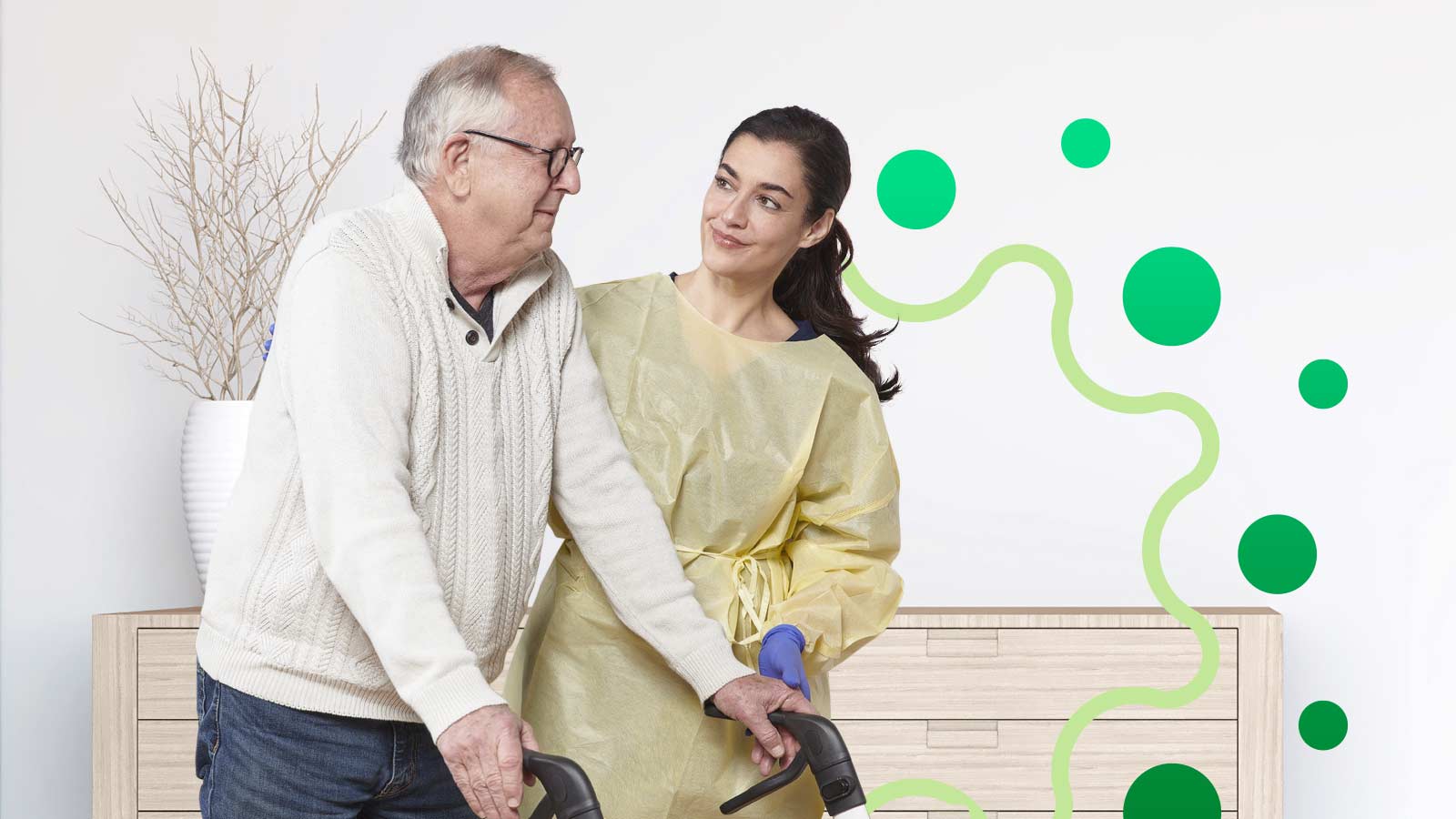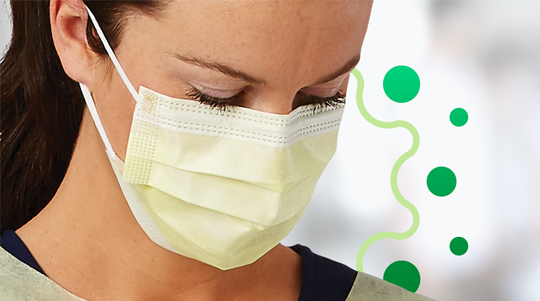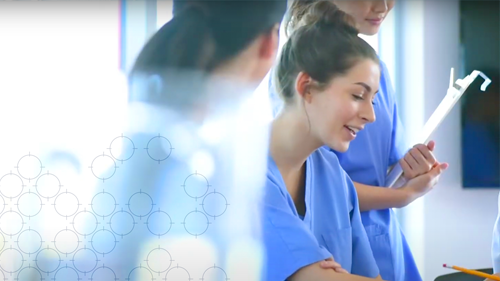Enhanced barrier precautions: 6 tips for implementing in LTCFs
EBP includes MDRO precautions and helps keep residents safer.

Table of contents
What’s in a precaution?
6 tips for implementing EBP
Related content
xxx
Nursing home residents have a high risk of infection. Why? Factors such as multiple medical conditions, indwelling and prosthetic devices, and group home living. In addition, immune system function decreases with age.1 And if that’s not enough, the spread of multidrug-resistant organisms (MDROs) is common in these facilities.
MDROs are microorganisms—predominantly bacteria but also fungi and viruses—that are resistant to multiple antibiotics or antifungals. This means certain drug treatments won’t work, making MDRO infections difficult to treat. The spread of MDROs is a big contributor to resident illness and death as well as higher healthcare costs.2
Studies have shown that more than 50% of nursing home residents have MDROs on or in their body, especially in wounds or medical devices such as indwelling urinary catheters (IUCs). Most of the time, people never know they are carrying these germs, meaning they are colonized with them and have no signs of infection. But under certain conditions, the germs can cause serious infections—or “superbugs”—that are hard to treat.3
How do you protect this vulnerable population—and facility staff? Learn how enhanced barrier precautions (EBP) can help stop the spread of MDROs and keep people safe.
What’s in a precaution?
Standard precautions
These precautions apply to the care of all residents, regardless of a resident’s suspected or confirmed infection or colonization status. Standard precautions are based on the principle that all blood, body fluids, secretions and excretions (except sweat) may contain contagious agents.
When staff select personal protective equipment (PPE), such as gowns and exam gloves, they should base it on their interaction with residents and the potential for exposure to blood, body fluids, or pathogens. And if splashes are possible during interactions, staff also should use face masks.2
More than 50% of nursing home residents have MDROs on or in their body.2
Contact precautions
Sometimes the spread of pathogens are not completely stopped by the use of standard precautions alone. Contact precautions are intended to prevent the transmission of infectious agents, like MDROs, that are spread by staff’s direct or indirect contact with the resident or the resident’s environment.
When these precautions are in place, staff must use a gown and gloves every time they enter a resident’s room. For the protection of others, residents on contact precautions are not to leave their rooms except for medically necessary care. This includes not being allowed to participate in group activities. Contact precautions generally are intended to be for a limited amount of time. When you implement these precautions, make sure to include a plan for stopping or reducing them.2
Enhanced barrier precautions
The Centers for Disease Control and Prevention (CDC) introduced guidance for enhanced barrier precautions (EBP) in 2019, but it wasn’t implemented due to the outbreak of the COVID-19 pandemic in 2020. In July 2022, the CDC updated its guidance on the use of EBP in nursing homes. The goal was to clarify the problem and impact of MDROs, the need for EBP, when and how to use EBP, and how to successfully implement these precautions.
Health care workers colonized with MDROs can contribute to colonization of nursing home residents because of their long contact with residents.1
With EBP, the use of PPE is expanded for everyone’s protection. Staff are required to use gown and gloves during high-contact resident care activities that might result in the transfer of MDROs to staff hands and clothing. MDROs then may be indirectly transferred from resident to resident during these high-contact activities, such as:
- Dressing, bathing and showering
- Transferring
- Providing hygiene
- Changing linens
- Changing briefs or assisting with toileting
- Device care or use: central line, IUC, feeding tube, tracheostomy/ventilator
- Wound care: any skin opening requiring a dressing2
In addition, EBP should be used during contact with all residents who have any of the following:
- Infection or colonization with an MDRO—when contact precautions do not apply
- Wound(s), regardless of MDRO colonization status
- Indwelling medical devices (e.g., central line, IUC, feeding tube, tracheostomy, ventilator) regardless of MDRO colonization status2
Again, face masks may be necessary to protect staff from splashes. Unlike with contact precautions, residents do not have to stay in their rooms, and they can still participate in group activities. EBP should be in place for the resident’s entire stay in the facility.2
Enhanced Barrier Precautions (EBP) is an approach of targeted gown and glove use during high-contact resident care activities, designed to reduce the spread of S. aureus and MDROs.2
“In regard to wounds, the size of the opening doesn’t matter—it’s simply a skin opening, whether a tear or a wound,” says Caryn Arnold, Medline Medical Science Liaison. “And it doesn’t matter whether the wound is chronic or acute.”
6 tips for implementing EBP
Getting started may seem overwhelming, but you’re not in it alone.
It’s best to work with stakeholders across the organization—everyone who is involved in the care of residents: director of quality, leadership (administrators, owners), lead RNs, lead CNAs, clinical and operations VPs and EVS leaders. You’ll want to form a committee to set expectations, establish standardized processes and define roles.
As you outline processes, keep in mind that PPE is only part of protecting residents and staff. It’s also critical that staff follow other recommended infection prevention practices—including proper hand hygiene, cleaning and disinfection of environmental surfaces and resident care equipment, proper handling of indwelling medical devices and care of wounds.4
“You may want to start with one thing, such as wounds, and expand to indwelling medical devices once you’ve nailed down the process,” says Alvarez. “I’d start with whichever is more prevalent in the facility.”
Make sure residents and their families know why staff is wearing PPE—for the resident’s and everyone’s protection.

Caryn Arnold
Medline Medical Science Liaison
The CDC has provided six recommendations for implementing PPE:
-
- Post clear signage on the door or wall outside of the resident room, indicating the type of precautions and required PPE (e.g., gown and gloves). For EBP, signage should also clearly indicate the high-contact resident care activities that require the use of gown and gloves. “Ensure staff are educated about the types of precautions and what they mean,” says Arnold, Medline Medical Science Liaison. “If a sign about contact precautions is on a resident door, staff may avoid entering. The resident is then left alone and isolated—and may get hurt trying to do things for themselves.” It’s also important to ensure that the new precautions don’t cause fear. The signs and PPE shouldn’t scare residents or their loved ones. You’ll want to be prepared to explain in simple language that it’s a way to keep residents safe from germs.
- Make PPE, including gowns and gloves, available immediately outside of the resident room. Your facility most likely has limited storage space—and a limited budget. “The goal is to make PPE available in an affordable, sustainable and practical way,” says Mark Chua, Medline Vice President of Preventive Care. “For example, you shouldn’t need a PPE cart for every hall. You can use rolling carts that are stocked with everything you need, which means you won’t need all PPE outside of every room.” In addition, disposable caddies are available. These PPE organizers can be hung on the wall outside resident rooms as needed. To reduce your need for storage space, consider participating in a supply management program. Some companies will stockpile products for you for a subscription fee. This approach ensures availability of the PPE you need.
- Ensure access to alcohol-based hand rub inside and outside every resident room. “Make sure that sanitizing hand wipes and alcohol-based hand rub are safely available to residents, family and other visitors—on bedside tables and nightstands if the resident can use them independently,” says Arnold. Caregivers should use alcohol-based hand rub in most clinical situations. Hand hygiene products should be available everywhere staff, residents and visitors go in a facility—from reception areas to dining rooms.
- Place a trash can inside the resident room and near the exit for discarding PPE after removal. Staff should remove and discard PPE before exiting the resident’s room or before providing care for another resident in the same room. You’ll want to make sure staff are educated on how to put on and take off PPE. And EVS staff should be educated on how to appropriately deal with discarded PPE.
- Monitor and assess adherence to determine the need for additional training and education. “It’s best to have a standardized process for educating staff,” says Arnold. “It should be conducted on a frequent basis as a refresher and to account for high staff turnover.” Make sure to include methods for reinforcing education (posters, etc.) in highly visible places. And you’ll want to meet regularly with team champions to monitor results.
- Provide education to residents and visitors. “Again, make sure residents and their families know why staff is wearing PPE—for the resident’s and everyone’s protection,” says Arnold. “PPE should be seen as a care tool like a wound dressing.” You’ll want to include hand hygiene education for residents and visitors. If possible, have hand hygiene brochures available. Help everyone understand that germs can live on surfaces for a long time and cause infections to spread. And make sure they have access to appropriate hand hygiene products.
The goal is to make PPE available in an affordable, sustainable and practical way.

Mark Chua
Medline Vice President of Preventive Care
Currently, the CDC recommendations on EBP are just that—recommended. The Centers for Medicare & Medicaid Services (CMS) is not surveying on EBP right now but may make changes to surveys based on EBP in the future.
The State Operations Manual was updated in October 2022 and includes language describing EBP in the section on MDROs. You may want to consider this information when planning for surveys. Now is the time to start small with EBP, apply lessons learned and then roll out facility-wide.
Key takeaway
Nursing home residents have a high risk of infection and often are colonized with MDROs, which can turn into serious infections that are hard to treat. By using enhanced barrier precautions, you’ll help prevent the spread of these superbugs. You can successfully implement EBP by putting together a team of champions, implementing the CDC’s six recommendations and using an affordable, sustainable and practical approach.
References:
- Juthani-Mehta, M., and Quagliarello, V. (2010, October 15). Infectious Diseases in the Nursing Home Setting: Challenges and Opportunities for Clinical Investigation. Clinical Infectious Diseases, 51(8), 931-936. https://www.ncbi.nlm.nih.gov/pmc/articles/PMC3083824/
- CDC. (2022, July 12). Implementation of Personal Protective Equipment (PPE) Use in Nursing Homes to Prevent the Spread of Multidrug-Resistant Organisms (MDROs). Implementation of Personal Protective Equipment (PPE) in Nursing Homes to Prevent Spread of Novel or Targeted Multidrug-resistant Organisms (MDROs) | HAI | CDC
- CDC (2022, July 12). Enhanced Barrier Precautions Letter to Nursing Home Staff. Help Keep Our Residents Safe – Enhanced Barrier Precautions in Nursing Homes (cdc.gov)
- CDC. (2022, July 12). Frequently Asked Questions (FAQs) about Enhanced Barrier Precautions in Nursing Homes. https://www.cdc.gov/hai/containment/faqs.html#:~:text=Enhanced%20Barrier%20Precautions%20require%20the,placement%20in%20a%20private%20room.





